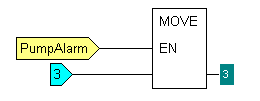| Function Name |
MOVE |
|---|---|
|
ST Operator |
:= |
|
Description |
The input is moved to the output. This is especially useful when used with the EN and ENO expressions as it allows the input to be moved to the output depending on the state of a boolean input (see Using EN and ENO to Control when a Function is Performed). |
|
Arguments |
Input 1 {ANY} For more information on the data types for the inputs and outputs, see Data Type Hierarchy. |
|
Returns |
Output {ANY} The Output = Input 1 |
Example:
Function Block Diagram - MOD:
A MOVE function is used to output a specific value when a defined input is True. To achieve this, an EN expression is used with the MOVE function. The EN expression uses a Boolean input from a direct input variable (PumpAlarm). The 'normal' input for the MOVE function has a constant input of 3. When the direct input variable is in State 1 (True), the constant value is moved to the output (so the output is 3). When the input variable is in State 0 (false), the output is 0.

In an ST Program there is no need to use a MOVE function as the same result can be achieved by using an IF-THEN statement.